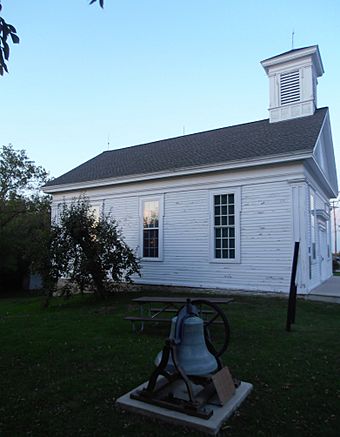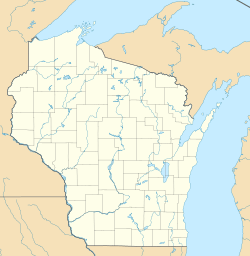Freewill Baptist Church facts for kids
Quick facts for kids |
|
|
Freewill Baptist Church
|
|
 |
|
| Location | 19750 W. National Ave., New Berlin, Wisconsin |
|---|---|
| Area | 0.5 acres (0.20 ha) |
| Built | 1859 |
| Built by | Church, Quincy W. |
| Architectural style | Greek Revival |
| NRHP reference No. | 97001409 |
| Added to NRHP | June 22, 1998 |
The Freewill Baptist Church is a special old building in New Berlin, Wisconsin. It's also known as the Prospect Aid Meeting House or Muskego Meeting House. This historic church was built way back in 1859. Because of its importance, it was added to the National Register of Historic Places in 1998.
Contents
Early Days of the Church
The area around the church, called Prospect Hill, was settled in the 1830s. Many of the first settlers came from New England and New York.
In 1840, a man named Rufus Cheney and his wife Ruth started the first Freewill Baptist church in what would become Wisconsin. They invited two other couples to join them. This type of Baptist church has roots in England.
The church grew steadily. In 1843, the first baptism took place. Rufus Cheney also started a school in his home for the children of church members. He became the pastor in 1845, but he never took any money for his work. Meetings were held weekly at his house.
Building the Church
By 1858, the church members had saved enough money to build their own church. Quincy W. Church, a member of the group, designed the building. He was the son of Prospect Hill's first store owner.
The church was designed in the Greek Revival style. This style was popular in New England churches. The building is balanced and even on the front. The main door is right in the middle.
On each side of the door, there are tall windows. The corners of the building have special flat columns called pilasters. Above the windows and pilasters, there's a decorative band called a frieze and a cornice.
A triangular shape called a pediment sits above that on the front. It has a unique sunburst design made from weatherboard. On top of the roof, a square belfry holds the church bell. It has small openings and a tiny pyramid roof.
Inside, the walls were made of lath and plaster. Deacon Hiram Hale paid for the choir loft himself. It stretched across the front of the building. Curved staircases at the corners led up to it.
The church never had running water. Outside, down a small hill, there was a small privy (outhouse). There were also sheds for horses and buggies, but these are now gone.
Community and Change
The church members were strongly against slavery. They collected food and supplies for the Union Army during the Civil War. They gathered blankets, potatoes, homemade socks, and other items.
In 1886, the Ladies Aid Society was formed. This group raised money for church furnishings and a bell. They also sewed quilts for children at an Indian Children's Home in Iowa.
A famous woman named Theodora W. Youmans grew up in this church. She became a pioneer journalist. She was also a leader in the women's suffrage movement in Wisconsin. This movement worked to get women the right to vote.
By 1886, the Freewill Church was able to hire a full-time minister. They also built a house for the minister. Prospect Hill had grown into a busy little town. It had stores, inns, blacksmith shops, and mills. The Freewill Baptists were a very important group in the community.
Later Years and Restoration
Over time, fewer people attended the church. By 1895, attendance was often less than a dozen. The congregation officially stopped meeting in 1925.
To keep the building going, the Ladies Aid Society changed its name. It became the Prospect Aid Society. This new group welcomed Christians from any church. The building was given to them. There was a rule that it could "never be used for dancing, card-playing, or raffling."
The Prospect Aid Society put in a cookstove. They also changed some church benches into tables. They hosted dinners, quilting bees, and summer meetings. The money they raised went to help charities. The building also served as a temporary home for other church groups.
By 1985, the rule about card-playing was removed. The society started holding monthly card parties. The money from these parties helped maintain the building and support charities.
In 1985, a fire damaged the roof, belfry, and inside of the church. It was caused by arson. Since then, the church has been restored. It now looks like it did in the past. Lunches are once again served there.



